Acupuncture is a practice that mainly involves insertion of thin needles (4 to 25 mm long) into the skin on specific points in the body in order to prevent illness and improve health and general well-being.
The practice originated in China more than 2,000 years ago and it’s one of the oldest medical practices known to man. The stimulation of sensory nerves results in the release of vital chemicals including endorphins.
Studies show that acupuncture treatment may reduce nerve pain and improve peripheral diabetic neuropathy.
Acupuncture Therapy Procedure
 After inserting (4-20) thin needles into specific areas in your body, the acupuncturist may leave them in for about 30 minutes or manipulate them via electric stimulation or with his hands.
After inserting (4-20) thin needles into specific areas in your body, the acupuncturist may leave them in for about 30 minutes or manipulate them via electric stimulation or with his hands.
However, different people describe the experience in different ways. Although some people report mild pain (a dull, throbbing sensation) especially during needle insertion, most patients report no pain whatsoever.
Some people become relaxed following the procedure, while others feel a burst of energy.
Follow-up treatments usually occur over a period of several months or weeks. However, treatments are customized to each patient’s symptoms and needs.
Benefits of Acupuncture for Diabetes
- Reduces pain and discomfort by regulating endocrine function
Diabetes mainly stems from the endocrine system because these hormones are mainly responsible for triggering organs to control our blood sugar levels. Acupuncture stimulates endorphins which block pain and trigger positive feelings in the body.
- Regulate sugar levels
Acupuncture regulates cortisol, a hormone which stimulates the body to feel stress. Studies show that the hormonal reaction triggered by acupuncture helps balance parts of the body that are unable to regulate blood glucose levels on their own. Therefore, unlike most pharmaceutical treatments, acupuncture helps regulate blood sugar levels without the risk of dangerous side effects.
Other Benefits of Acupuncture for T1D (Type 1 Diabetes) include:
- Decreasing depression and anxiety
- Preserving nerve function and alleviating painful diabetic peripheral neuropathy
- Increasing gastropareisis (gastric emptying time)
- Increasing circulation
- Increasing range of motion especially in musculoskeletal conditions such as trigger finger and frozen shoulder
- Reduce the release of glucagons by the pancreas
- Reduce the urge to eat too much (polyphagia), excessive thirst (polydipsia) excessive urination (polyuria)
- Prevent myocardial contractility and microcirculation
- Normalize vascular peripheral resistance and enhance blood outflow
- Enhance immunomodulating antioxidant and antiatherogenic effects
- Stimulate secretion of beta-endorphin
- Elevate pain threshold
- Increase neuropeptide Y levels and cell proliferation
- Reduce antheroscelerosis of the limbs
Acupuncture also supports the immune system’s ability to fight off viruses and colds. As we all know, illnesses can cause fluctuations in blood glucose levels especially for people suffering from Type 1 Diabetes.
How does Acupuncture Work?
Although the mechanisms of acupuncture are not fully understood, studies show that acupuncture stimulates the body’s regulatory systems to produce chemicals that reduce inflammation and pain, trigger the secretion of neurotransmitters and neurohormones in order to restore homeostasis.
On the other hand, the blood glucose lowering effects are due to the regulation of cortisol, a hormone that stimulates the liver to produce glucose and by reducing the concentration of fatty acids in the blood, which increases insulin sensitivity.
Does Acupuncture have any Shortcomings or Risks for Diabetes?
Recent studies and clinical trials of acupuncture therapy for diabetes have proven that acupuncture does not have any serious risk. However, this does not mean that acupuncture is for everyone.
As Mayo Clinic points out, although diabetes can be controlled and treated, there’s no diabetes cure. Therefore, if you’re unable to manage diabetes symptoms through lifestyle choices and diet, you’ll need insulin therapy.
There are a few general risks associated with acupuncture treatment that we should be aware of. Some of the side effects of acupuncture include bruises, soreness, and minor bleeding where the needles have been inserted.
All needles must be removed after the procedure as this could have serious adverse effects. On the other hand, if you have a bleeding condition like vitamin K deficiency, are pregnant or have a blood disease such as HIV or hepatitis, acupuncture might not be the best treatment option for you.
Guidelines for Acupuncture Therapy for Diabetes:
Acupuncture treatment usually includes the following:
- During your initial appointment, the acupuncturist will ask you detailed questions about your diabetes condition and specific symptoms.
- Your practitioner will ask you questions about your pain levels, diet, health goals and lifestyle. Your acupuncturist might also ask questions about stress, relationships and any other area of your life that has a holistic impact on your condition.
- After the initial consultation, the treatment procedure usually takes approximately 30 minutes. Your acupuncturist will most likely recommend that you go for treatments twice per week to see how your body is reacting.
If everything goes well, your practitioner will probably drop your treatment appointments to twice a month.
Remember, the first and most important treatment for diabetes is a healthy lifestyle which generally includes a sustainable and pleasurable habit of stress management, nutrition and physical activities. This is the starting point of a holistic and integrative approach to diabetes and other chronic medical conditions.
